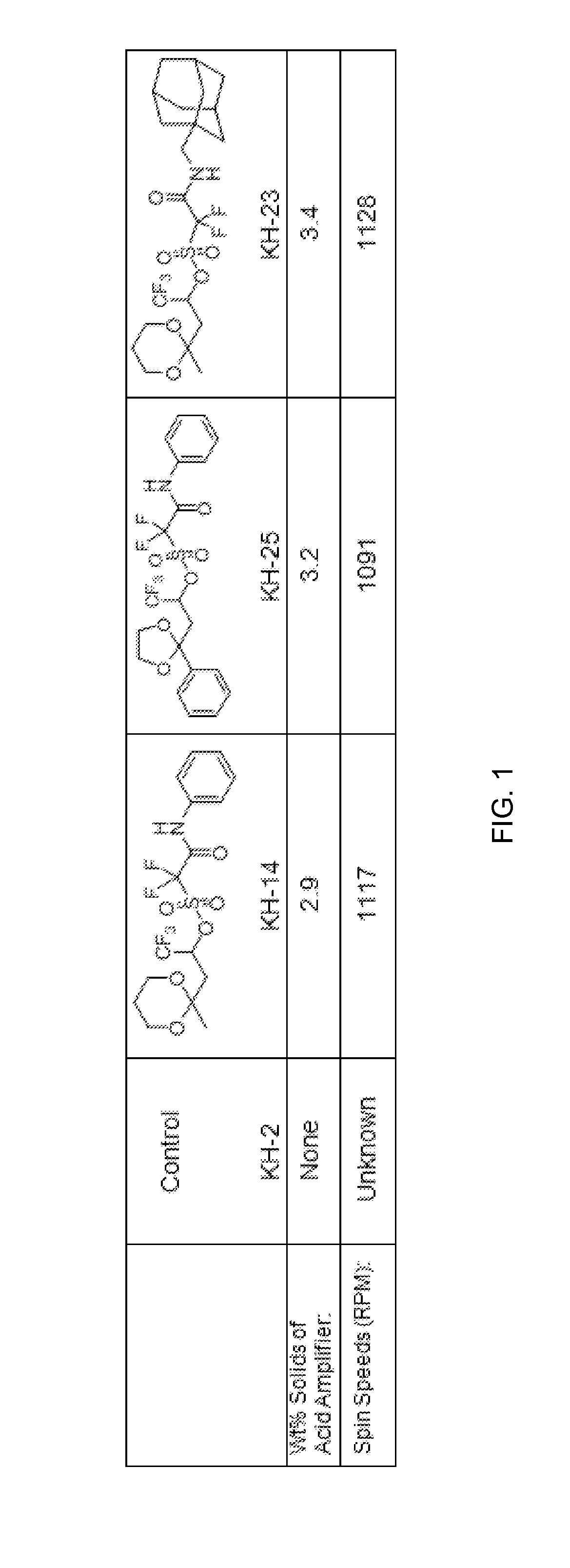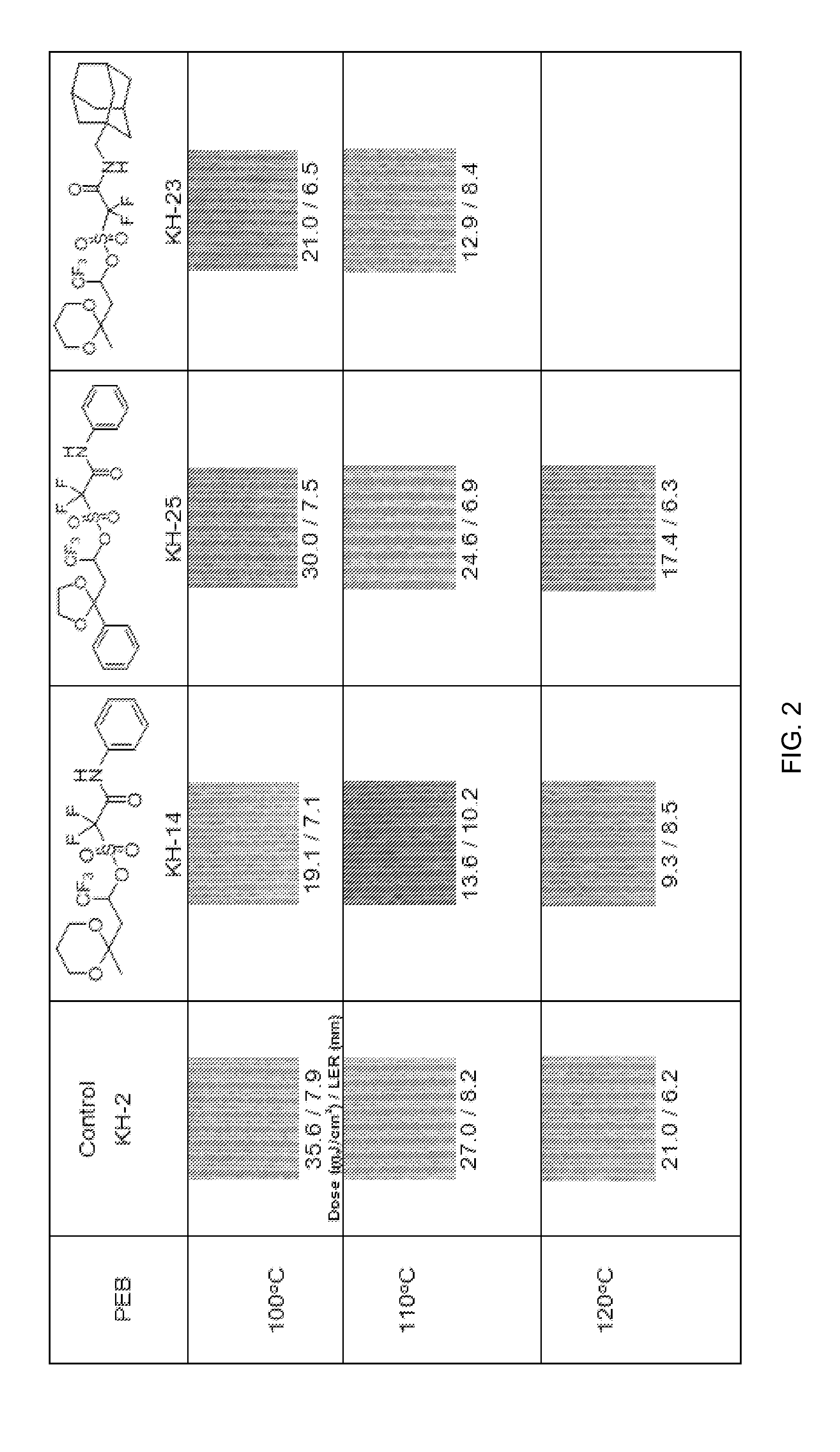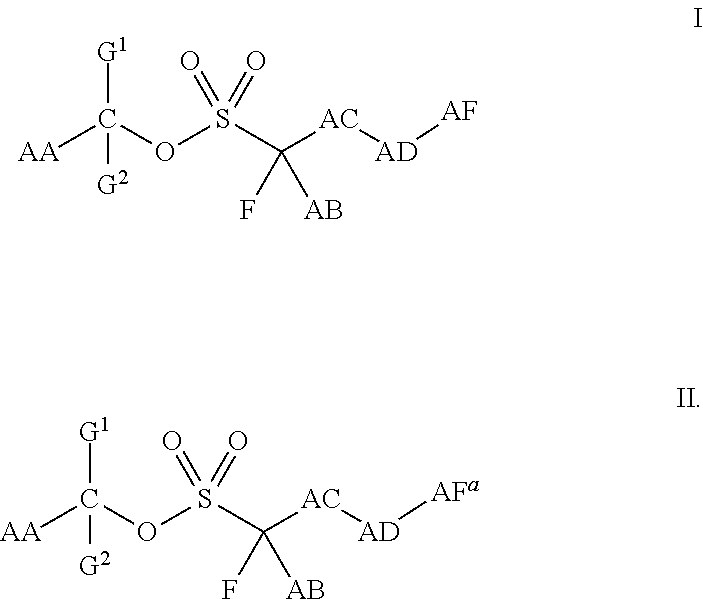Stabilized acid amplifiers
a technology of acid amplifiers and resist films, which is applied in the direction of photosensitive materials, instruments, photomechanical equipment, etc., can solve the problems of volatile compounds that can leave the resist film, the phenolic materials commonly used for photolithography using light wavelength 248 nm wavelength are generally not suitable for use as photoresists, and the performance decline, etc., to achieve the effect of facilitating the activation of the trigger, reducing the energy consumption of the trigger, and increasing the stoich
- Summary
- Abstract
- Description
- Claims
- Application Information
AI Technical Summary
Benefits of technology
Problems solved by technology
Method used
Image
Examples
example 1
Preparation of 2-(1-Adamantanemethylamino)-1,1-difluoro-2-oxoethaneesulfonyl fluoride 3
[0288]
[0289]1-Adamantanemethylamine 2 (0.80 g, 4.84 mmol) and pyridine (0.40 g, 5.08 mmol) and CH2Cl2 (10 ml) were placed into a round bottom flask that was purged with nitrogen. 2,2-Difluorosulfonylacetyl fluoride 1 (0.87 g, 4.84 mmol) dissolved in THF (5 mL) was added dropwise to the flask at 0° C. and the solution was stirred for 2 hours. The reaction mixture was diluted with ethyl acetate (20 mL) and washed with 1M HCl (20 mL) and sat. NaHCO3 aq. (20 mL) and brine (20 mL). The organics were dried with Na2SO4 and the solvent was concentrated under reduced pressure. The crude product was purified by column chromatography with ethyl acetate and acetone in hexane to give the product 3 (1.38 g). 1H NMR (400 MHz, Acetone) δ 3.10 (d, J=6.6, 2H), 1.96 (s, 3H), 1.69 (dd, J=33.0, 12.2, 6H), 1.55 (d, J=2.3, 6H).
example 2
Preparation of 1,1,1-Trifluoro-3-(2-methyl-1,3-dioxan-2-yl)propan-2-yl 2-(1-adamantanemethylamino)-1,1-difluoro-2-oxoethanesulfonate 5
[0290]
[0291]1,1,1-Trifluoro-3-(2-methyl-1,3-dioxan-2-yl)propan-2-ol 4 (0.346 g, 1.614 mmol) and THF (3 mL) were added to a 50 mL two neck flask that had been purged with nitrogen. The flask was cooled to −78° C. 1 M lithium hexamethyldisilazide (LiHMDS) in THF (2.0 ml, 2.03 mmol) was added dropwise to the flask and stirred for 20 minutes at −78° C. 2-(1-Adamantanemethylamino)-1,1-difluoro-2-oxoethaneesulfonyl fluoride 3 (0.500 g, 1.536 mmol) dissolved in THF (3 mL) was added dropwise to the flask and the solution was stirred for 24 hours during which time the solution reached room temperature. The reaction mixture was quenched with 1M HCl (10 mL) and diluted with ethyl acetate (30 mL). The organic layer was washed with sat. NaHCO3 aq. (15 mL) and brine (15 mL). Then the organic layer was dried with Na2SO4 and the solvent was removed under reduced pres...
example 3
Preparation of (1-Adamantanemethyl)-2,2-difluoro-2-(fluorosulfonyl)acetate 7
[0292]
[0293]1-Adamantanemethylalcohol 6 (3.32 g, 19.9 mmol) and pyridine (1.65 g, 20.89 mmol) and CH2Cl2 (20 ml) were placed into a round bottom flask that was purged with nitrogen. 2,2-Difluorosulfonylacetyl fluoride 1 (3.60 g, 19.9 mmol) dissolved THF (10 mL) was added dropwise to the flask at 0° C. and the solution was stirred for 2 hours. The reaction mixture was diluted with ethyl acetate (30 mL) and washed with 1M HCl (20 mL) and sat. NaHCO3 aq. (20 mL) and brine (20 mL). The organics were dried with Na2SO4 and the solvent was concentrated under reduced pressure. The crude product was purified by column chromatography with ethyl acetate and acetone in hexane to give the product 7 (4.83 g). 1H NMR (400 MHz, Acetone) δ 4.05 (s, 2H), 2.03 (s, 3H), 1.71 (dd, J=37.3, 11.9, 6H), 1.57 (d, J=2.4, 6H).
PUM
| Property | Measurement | Unit |
|---|---|---|
| wavelength 248 | aaaaa | aaaaa |
| wavelength 248 | aaaaa | aaaaa |
| temperatures | aaaaa | aaaaa |
Abstract
Description
Claims
Application Information
 Login to View More
Login to View More - R&D
- Intellectual Property
- Life Sciences
- Materials
- Tech Scout
- Unparalleled Data Quality
- Higher Quality Content
- 60% Fewer Hallucinations
Browse by: Latest US Patents, China's latest patents, Technical Efficacy Thesaurus, Application Domain, Technology Topic, Popular Technical Reports.
© 2025 PatSnap. All rights reserved.Legal|Privacy policy|Modern Slavery Act Transparency Statement|Sitemap|About US| Contact US: help@patsnap.com



